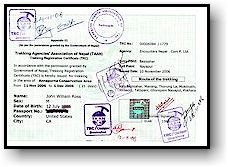Nepal - Trekking Registration Certificate
Note: In 2007, the TRC was replaced by a new document called the TIMS (Trekkers' Information Management System). It is much like the TRC. To learn more about the TIMS, go here.
Since late October 2006, trekkers in Nepal are required to have a new document called the Trekking Registration Certificate or TRC. There are still a few regions where you can trek without one but generally all the popular routes are covered. You cannot get your Annapurna Conservation Area Entry Permit without first getting a TRC. and you cannot get the TRC without going through a registered trekking agency. Stipulated in the TRC are requirements that you are to be accompanied by at least one guide or porter. The government says they instituted this law to regulate the industry and ensure the safety and well being of the trekkers however, many look at it as a successful lobby from the trekking agencies who now reap in much more business. Regardless, you will be asked to show this certificate while on your trek and you will be turned back if you do not have it.
November 2006: Before leaving for Nepal, we did much research regarding the Annapurna Circuit and Annapurna Sanctuary treks We found good guide books and realized that we could very easily find our way without a guide or porter. When we arrived in Nepal however, we discovered that we were required to plan our trip through a qualified trekking agency and be accompanied by either a porter or a guide. At first we were bummed out but in retrospect, having our guide (and a porter we hired on the fly) made our experience more enriching and rewarding. Our guide cost us $10 USD per day and the porter we hired in Bhulbhule an additional $9 / day. From these amounts, they paid for all of their food and lodging on the trek.
Some TRC details
The TRC is issued by the trekking agency. It costs $3.50 USD per person. It is valid for a limited time period (usually the time of your trek). We overstayed our TRC by about a week and had no problems at the check points. The Trekking Registration Certificate has an entry point and exit point and lists the routes where you may go. We went out at a different point and had no problems. See a large image of a trekking registration certificate here.
Areas where the TRC is required: Annapurna, Dhaulagire Region, Khaptak National Park, Lang Tang Nat. Park, Makalu Barun Nat. Park, Rara Nat. Park, Rolwaling Area, Sagarmatha Nat. Park.
Areas where you can trek without the TRC: The Shailung area, Kathmandu valley; The trekking routes of Ganesh Himal via Gorkha and Lamgung; Nuwakot, Dhading and Rasuwa districts; Sirubari or Syangja district; Millennium trekking area lying between Kaski and Syangja districts; South of Solu below Lukla.
Avoiding the TRC
It is not legal but there are at least three ways that we have seen where people have worked around the system. 1) If you speak good Nepali or have a good interpreter, you can likely get the TRC on your own and have any Nepali person accompany you on your trek. This requires some bureaucratic maneuvering 2) Bribe a trekking agency to issue you a certificate with no porter or guide to accompany you. If you get questioned on the trail, tell them you think your guide went ahead of you earlier (or is a ways behind you). One person we encountered that did this paid about $60 USD for the certificate. 3) From Nepal, find a group of people that are going on the same trek as you are and "join" them and their porter / guide for the purpose of getting the certificate. Once on the trail, head off on your own.
TRC Document |
|||||
